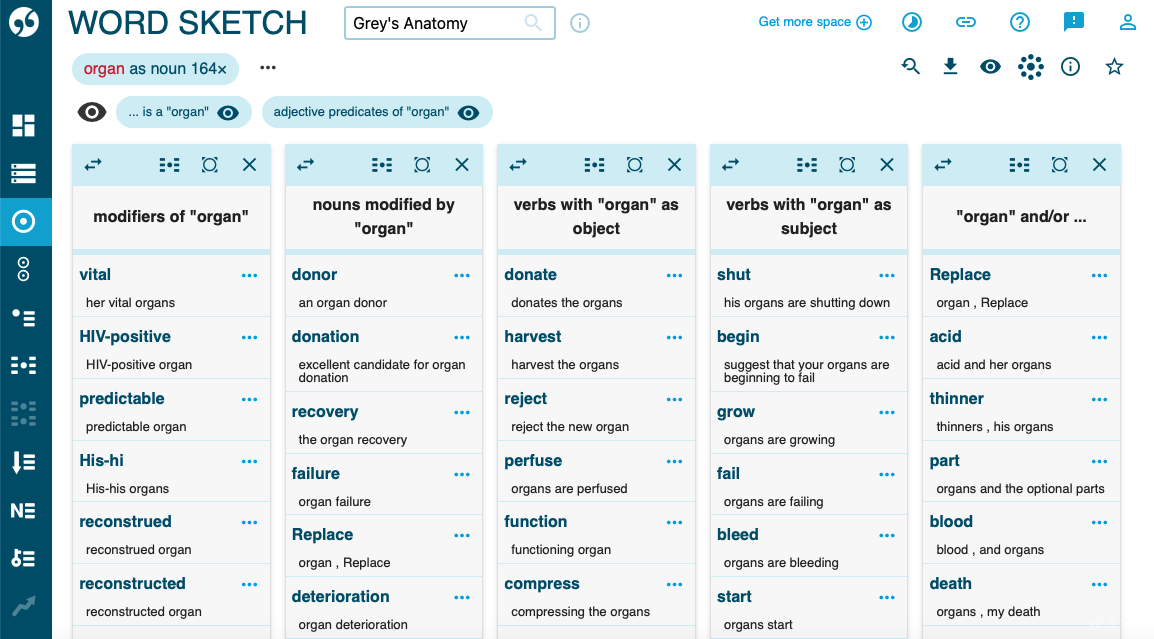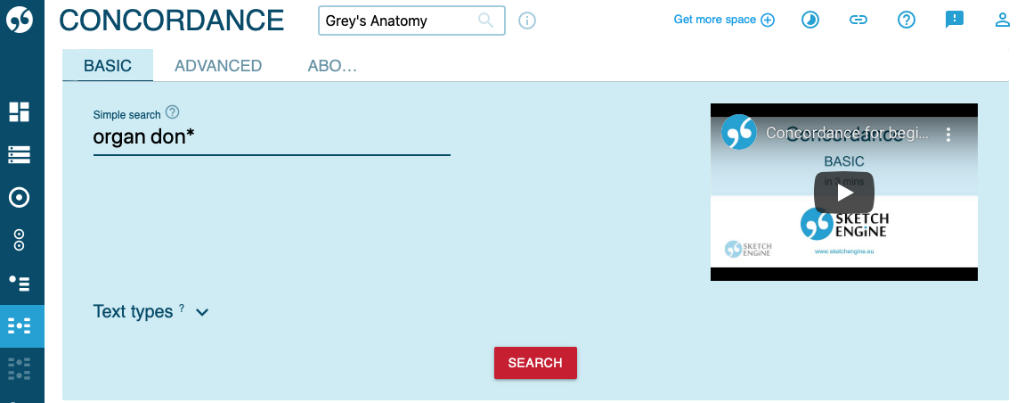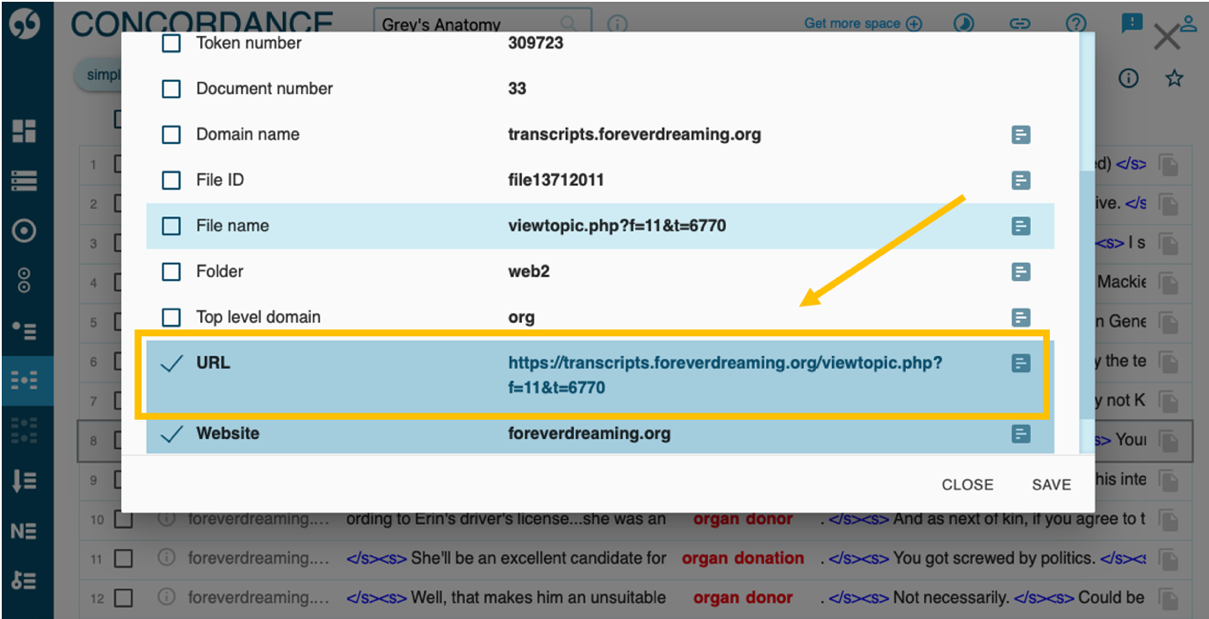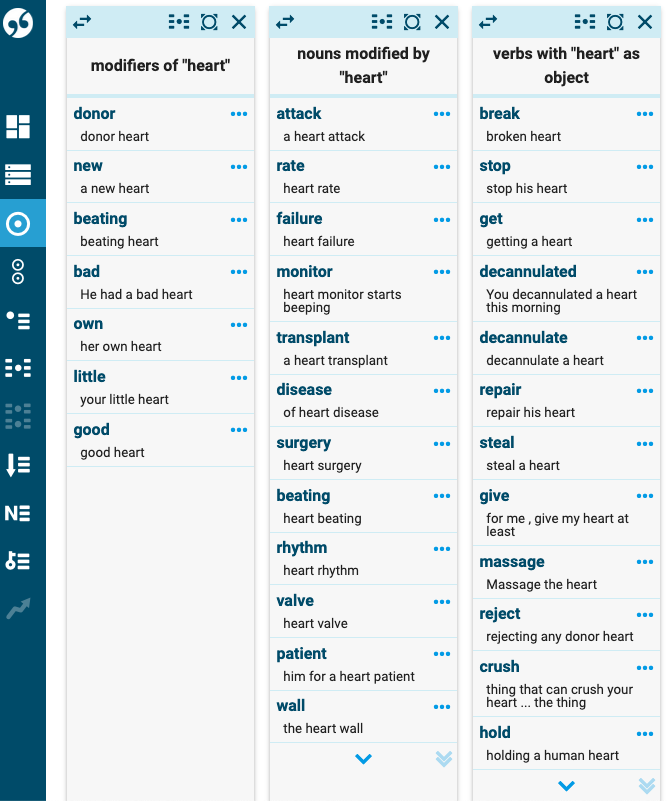Lesson ideas: Vocational education and English for Specific Purposes (ESP)
15 Exploring hospital interactions with Grey’s Anatomy
Building and exploiting a TV series corpus for nursing vocational schools
Simone Campos Silva
1 Introduction and rationale
“Words – so innocent and powerless as they are, as standing in a dictionary, how potent for good and evil they become in the hands of one who knows how to combine them.” (Hawthorne)
The International Council of Nurses states:
Nursing encompasses autonomous and collaborative care of individuals of all ages, families, groups and communities, sick or well and in all settings. Nursing includes the promotion of health, prevention of illness, and the care of ill, disabled and dying people. Advocacy, promotion of a safe environment, research, participation in shaping health policy and in patient and health systems management, and education are also key nursing roles. (ICN, 2002)
Communication and interaction are particularly important competences to be able to fulfil the tasks described above. This year’s newly designed and revised German nursing apprenticeship introduces a new curriculum, which describes communication as a key nursing activity (Ammende et al. 2019: 51). Moreover, subjects of general education should be taught with connection to nursing topics (Niedersächsische Landesschulbehörde 2019). As English is one of those general education subjects, communication in hospital settings can be efficiently combined with learning English. Talking to and supporting patients and their next of kin in difficult and life-threatening situations can be a challenging task during a nursing apprenticeship. Therefore, practicing those kinds of situations in a protected and sheltered environment is of crucial importance. The series Grey’s Anatomy offers the possibility to examine many different challenging interactions and communications in hospital settings. Consequently, students have the opportunity to learn from those interactions and develop communication strategies in the most widely used lingua franca, English.
Outline and objectives
- This lesson is designed for B1 to C1 vocational school learners of English (intermediate to advanced) who are training to become nurses.
- The aim is to focus on communication and interaction in hospital settings in order to support and help nursing students.
- Teachers should plan around 2-2.5 hours to follow all steps described to prepare the class session.
2 Corpus, tools and methods
The corpus building tool Sketch Engine is used for this chapter. Sketch Engine offers the possibility to build and analyse custom-made corpora compiled from texts from the web. Unfortunately, Sketch Engine is not free to use, but there is a free 30-day trial, which is more than sufficient for this lesson. Simply create a free trial account and you will be able to start working with corpora.
Grey’s Anatomy was created by Shonda Rhimes and is a “prime-time American television medical drama that debuted on the American Broadcasting Company (ABC) network in 2005. […] The program focuses on the personal and professional lives of surgical interns and their medical mentors.” (Encyclopaedia Britannica 2018). Momentarily, Grey’s Anatomy comprises 16 seasons. Due to its award-winning success, the series is famous worldwide. Therefore, students might enjoy learning English with the help of a TV drama they know.
In this chapter, Sketch Engine’s corpus building functions and the Grey’s Anatomy scripts will be combined to create an English learning environment for nursing students.
3 Step-by-step guide for teachers
Below you will find instructions on how to build your own Grey’s Anatomy corpus and how you use tools on Sketch Engine to work with this corpus in order to create work sheets for students.
Teacher preparation
Corpus compilation
- Open the website Sketch Engine (https://www.sketchengine.eu). Create an account and then log in.
- As soon as you are logged into your account, you will find an option to create your own corpus in the upper right corner of your dashboard. Click on “NEW CORPUS” (Fig. 1).

- In the next step, you will be asked to name your corpus (e.g. Grey’s Anatomy), to choose a corpus type (single language corpus), to select a language (English), and to shortly describe your corpus if needed (Grey’s Anatomy scripts). After that, click on the red button “NEXT”.
- Now, you can start adding texts to your newly created corpus. There are two options to do so: you can either find texts on the web or upload your own texts from your computer. In this case, choose “Find texts on the web” (Fig. 2).

- Before being able to upload texts from the web into your corpus, you need to find a website from which you would like to upload data. In this case, just google “Grey’s Anatomy scripts” and you will find different pages that offer scripts of all the Grey’s Anatomy seasons. Choose one of them, e.g.: https://transcripts.foreverdreaming.org/viewforum.php?f=11 (last accessed 16 June 2020).
Unfortunately, it is not possible to just copy the link to the whole website as it – like many other websites – does not only contain Grey’s Anatomy scripts but also other TV seasons scripts. In order to make sure that you only upload Grey’s Anatomy scripts to your corpus, you need to open each episode’s webpage separately and copy the URLs. If you decide to choose a different website, just make sure to find one without too many fan comments etc. as all those comments will also be added to your corpus. - Grey’s Anatomy comprises 16 seasons with often more than 20 episodes each. Sketch Engine’s default maximum amount of 1,000,000 words for a custom-made corpus will not be enough for the scripts from all 16 seasons. Consequently, you can only upload parts of the Grey’s Anatomy seasons. 1,000,000 words should enable you to upload about twelve seasons to your corpus.
- Sketch Engine gives you three different options for finding texts on the web: “Web search”, “URLs” or “Website”. This time choose the second option: “URLs”. Sketch Engine requires you to paste every single URL from every episode you would like to add to your corpus. After pasting one URL, always press “Enter” on your keyboard in order to add the next URL (Fig. 3).
- It will be easier to manage your corpus later if you create separate folders for each season. To do so, choose folder names: For season 1 = season1, season 2 = season2, season 3 = season3, etc. (Fig. 3).
- Click on the red button “GO” and Sketch Engine will start to upload data from the webpages and build your Grey’s Anatomy corpus (Fig. 3).

- Once the uploading process is finished, you can repeat the exact same procedure with the next season. Therefore, come back to your dashboard (Fig. 1) and click on “Manage corpus” on the upper left side. Then choose the option “Make bigger” (Fig. 4), which will bring you back to the screen in Fig. 2. Now, follow steps 7 to 9 again for as many seasons as you would like to include or until you reach Sketch Engine’s maximum free word count of 1,000,000 words.

Corpus queries and work sheet creation
I will present two functions of Sketch Engine that allow you to exploit your corpus for English language teaching: Word Sketch and Concordance. These functions can be used to create work sheets for your students.
Using ‘Word Sketch’ to create a vocabulary list on a certain topic
With the help of your newly built Grey’s Anatomy corpus, it is very easy to build a vocabulary list on a specific topic. You are completely free to decide on a topic. As an example, this chapter will focus on the topic of organ donation. Here we shall create a word sketch for the noun organ:
- On your Sketch Engine dashboard, click on the option “Word Sketch” (Fig. 5).

- Use the basic search function. You will be asked to type in a lemma. In this case, type in organ and click on “GO” (Fig. 6).

- Finally, you will obtain lists of words that are frequently associated with the word organ in Grey’s Anatomy (Fig. 7).

- With the help of your Word Sketch of the word organ, you can create a vocabulary list including useful collocations and prepositions, for your students. Copy the words and collocations that you want your students to learn and paste them in a separate document. Consider choosing vocabulary based on your pedagogical experience. As the Word Sketch shows the most frequent collocates, it is up to you to choose useful vocabulary. An example vocabulary list can be found in Appendix 1.
- Students can practise the new vocabulary by filling in a cloze text based on the Word Sketch list. To create such a cloze exercise, click on “Concordance – see all collocates in this column in context” (Fig. 8).

- In the menu, click on “KWIC” and select the option “sentence” (Fig. 9). You will see how the words from your vocabulary list are used in context of the Grey’s Anatomy scripts.

- Decide on which sentences you want to add to your cloze exercise, copy them and add appropriate gaps. An example cloze exercise can be found in Appendix 2.
Using ‘Concordances’ to extract dialogues from the episodes
Nursing students may worry about how to address patients and their next of kin about difficult situations such as a life-threatening diagnosis, death or organ donation. Staff-patient-interactions in Grey’s Anatomy provide a very valuable source of such interactions in English. Needless to say that such constructed conversations and interactions cannot exactly mirror real hospital situations. Nevertheless, they can be used to practise dealing with emotional situations in a safe classroom environment. Students may benefit from these dialogues by focusing on discourse markers, fillers, distance and empathy, or other communicative strategies in dialogues.
Again, the Grey’s Anatomy corpus proves to be a useful tool in finding the interactions mentioned above:
- Go to the dashboard. Click on “Concordance” (Fig. 10).

- Use the basic search function and type in organ don* in order to find text passages in your corpus that include the words organ donor/donors/donation. Further possible results might be organ donating/organ don’t etc. Click on the red button “SEARCH” (Fig. 11).

- Sketch Engine will show you all the text passages in your corpus that include the words organ donor/donors/donation (Fig. 12).

- Choose one of the given text passages. clicking on the red writing (KWIC), you can read more from the scene about organ donation which might be helpful to decide on a suitable text passage (Fig. 13).

- After having found a suitable text passage, click on the information icon or the URL next to the concordance line to obtain more information about the episode in which this scene can be found. Click on the URL and you will be forwarded to the full Grey’s Anatomy script (Fig. 14).

- Use the search function in your browser to find the text passage in the full Grey’s Anatomy script displayed on that web page and copy the relevant text passage from the script. An example of a dialogue on organ donation based on the series Grey’s Anatomy and found with this method can be found in Appendix 3.
- With the help of the Concordance list on Sketch Engine it is possible to find suitable text passages in the Grey’s Anatomy scripts where medical staff talk about organ donation to the next of kin. If possible, you could also show the video of that scene as an introduction to the topic.
Lesson plan and tasks
|
Time/Phase |
Content |
Method/Media |
|
5 minutes |
Show sequence from Grey’s Anatomy episode about organ donation and doctors talking to next of kin |
Clip from Grey’s Anatomy episode |
|
10 minutes |
Defining the term organ donation. |
Classroom discussion; Blackboard |
|
20 minutes |
Students receive a cloze text based on the Word Sketch and Concordance lines from Sketch Engine, which they can fill in with help of the vocabulary list. Compare results. |
Cloze Vocabulary list |
|
15 minutes |
Students receive three different dialogues about organ donation illustrating staff-patient-interactions. Tasks: How is this interaction structured? How well did the participants handle the situation? What could be improved? |
Dialogues from the series |
|
20 minutes |
Students receive a new task: Imagine taking care of a brain-dead patient. How would you address the possibility of organ donation to the next of kin? Remember the introduction sequence. Develop a dialogue with a partner. |
Pair work |
|
10 minutes |
Students present their dialogues (voluntarily) and their peers give feedback. |
– |
|
10 minutes |
Create a list of phrases students might want to remember for staff-patient-interactions in general. |
– |
4 Options and further ideas
The class session described above focuses on the topic of organ donation, but you could easily prepare a lesson focusing on care, heart disease or dementia, as these topics are discussed in Grey’s Anatomy, too. Word Sketches on care and heart can be found in Appendix 4.
Furthermore, although the example lesson proposed in this chapter is designed for nursing school students, the tools described can be used for all kinds of professions in vocational schools. When teaching students who want to become mechanics, you could use Titus or Transporter to build a corpus of language material from that subject area. Similarly, for culinary students, Chef’s Table may be a useful TV series to create such corpus-based lessons.
5 Caveats and limitations
Sketch Engine offers the possibility to create a 30-day free trial account. This limits teachers’ use of the interface to just 30 days. However, within a month, Sketch Engine can be used to create many corpus-based tasks and activities.
Another limitation is that Sketch Engine sets a default word limit to 1,000,000 words for a custom-built corpus. This may seem like a lot at first glance but depending on the focus of the lesson(s), more words might be desirable.
6 Conclusion
This chapter is designed to as a teachers’ guide to preparing lessons on staff-patient-communication when teaching English to nursing students. Interactions in hospital settings are explored with a linguistic corpus from the series Grey’s Anatomy in order to develop teaching material for vocational schools. The episodes consist of dialogues only, thus they are an excellent source of language for students to improve their communications skills. Moreover, the suggested lesson serves as a general example: the range of TV series available offers a wealth of language data that can serve as the basis for creating language teaching materials on a wide array of topics and communicative situations. There are no limits to the teacher’s creativity. Although the process of building your own corpus is somewhat time-consuming, task design is in fact easier and faster with the help of a corpus. What’s more, corpus-based tasks are based on authentic, native-like language. This is likely to be particularly helpful to non-native teachers and English teachers at vocational schools, who are teaching students learning a profession they are not familiar with themselves. To conclude, both students and teachers can profit from working with a linguistic corpus.
7 Resources and references
Ammende, Rainer, Frank Arens, Ingrid Darmann-Finck, Roswitha Ertl-Schmuck, Brigitte von Germeten-Ortmann, Gertrud Hundenborn, Barbara Knigge-Demal, Uwe Machleit, Christine Maier, Sabine Muths & Anja Walter. 2019. Rahmenpläne der Fachkommission nach § 53 PflBG. https://www.bibb.de/dokumente/pdf/geschst_pflgb_rahmenplaene-der-fachkommission.pdf (26 January, 2020).
Encyclopaedia Britannica. 2018. Grey’s Anatomy. https://www.britannica.com/topic/Greys-Anatomy (8 February, 2020).
Forever Dreaming. 2020. Grey’s Anatomy transcripts. https://transcripts.foreverdreaming.org/viewforum.php?f=11 (16 June, 2020).
International Council of Nurses (ICN). 2002. Nursing definitions. https://www.icn.ch/nursing-policy/nursing-definitions (26 January, 2020).
Niedersächsische Landesschulbehörde. 2019. Grundlegendes zur neuen Ausbildung nach PflBG. https://www.landesschulbehoerde-niedersachsen.de/themen/berufe-im-gesundheitswesen/pflegefachfrau-und-pflegefachmann/pflegefachfrau-und-pflegefachmann (26 January, 2020).
Sketch Engine. 2020. What can Sketch Engine do? https://www.sketchengine.eu/what-can-sketch-engine-do (26 January, 2020).
8 Appendices
Appendix 1
Vocabulary list
| vital
her vital organs reconstrued reconstrued organ removable removable organs weakened weakened organs abdominal his abdominal organs damaged damaged organ transplant transplant organ internal internal organs |
donor
organ donor donation organ donation recovery organ recovery failure organ failure fail organs are failing bleed organs are bleeding donate donate the organs reject reject the new organ |
Appendix 2
Cloze exercise
- Don’t make a move until we get our hands on every ______________ around the tree trunk.
- Chief, I know the hypothermia is protective to her ______________ but how much longer do you think we can go on like this?
- This guy could have pretty good life with a ______________ that my boy here and I could make tomorrow.
- We were on a plane, and we just picked up a ______________ from a kid who died.
- He was born with his ______________ outside of his body.
- Grow it in the lab, remove the ______________. Replace it with a newer model.
- That is that the surgery was too intense for his ______________ to support.
- All, all it means is that ah some of the baby’s ______________ are growing in a sac outside its body
- Ah, we have an ______________ coming in this afternoon from Wilkeson General.
- He is an excellent candidate for ______________.
- I’m afraid you’re gonna go into multi-system ______________ if we don’t operate.
- To a critically ill patient, an ______________ means a new start, a second chance.
Appendix 3
A conversation about organ donation
Addison: I know Kendra meant the world to you and I know the terrible grief you must be going through right now, but from a medical standpoint, this is a very bad idea.
Mr. Thomas: Well, if we’d wanted your opinion, miss, we’d ask for it.
Mrs. Thomas: It’s just…we love our daughter. Please try to understand.
Addison: I do understand. I do. You think if you love her enough or love her baby enough that it will keep her close to you. But she’s already gone and if you go forward with this, you’re risking…I mean, if Kendra, were to contract an infection, she could pass it on to the fetus and it could cause brain damage…
Mr. Thomas: We’re taking our chances.
Mrs. Thomas: Now…they keep organ donors alive after they’re…gone. Why not Kendra?
Addison: Organ donors aren’t kept alive for six months. Your daughter is brain dead. She can’t regulate body temperature, hormone output. These things are very important for a fetus.
Mr. Thomas: You guys can regulate that stuff, right?
Addison: We could try. I…
Mr. Thomas: Well then try, damn it! What the hell’s the problem here?
Addison: The problem, as I see it, is you want to use your daughter’s corpse as an incubator. That’s the problem.
Derek: Ok, I’m sorry. Would you excuse us?
Source: https://transcripts.foreverdreaming.org/viewtopic.php?f=11&t=6770 (16 June 2020)
Appendix 4
Word sketches of care and heart can be generated and worked with as described in Section 4.1.2.1.


